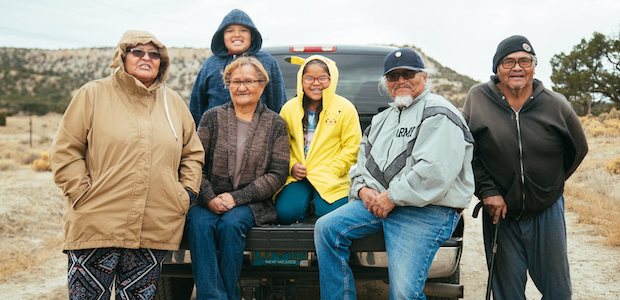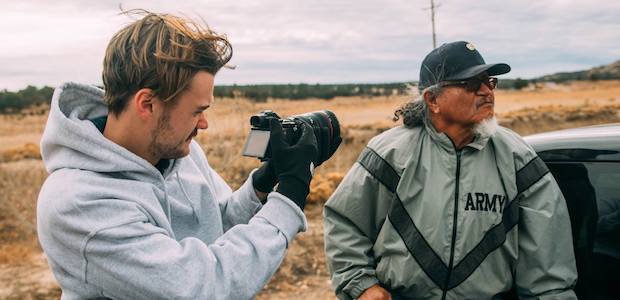Louis Berry
The director of Tale of a Toxic Nation on turning his powerful short into a feature film.

Earlier this year a crew of recent grads from the Digital Film Program at Ravensbourne set out across America, initially for the adventure and the scenery, but soon discovered a tragedy and a travesty, both of which could have been circumvented. In the deserts of Arizona and Utah, the Navajo nation has been left ravaged by abandoned uranium mines that have decimated the native population with cancers directly attributable to the radiation pollution. Not only has the government forever scarred these sacred lands, but, under Trump, has even stopped cleaning up the mess they created. And what is truly unpardonable is that the Trump administration has opened up even more land to this destructive practice with little regard for the lives and traditions of a people who were on the land well before any white immigrants decided this land was theirs to squander.
In a powerful and insightful new documentary short, director Louis Berry, cinematographer Toby Leary, and editor Callum Pearson have created a work of passion and intensity and social commitment. They talked to me about the film and their journey to turn the short into a feature. Tale of a Toxic Nation is an urgent and vital project that sets out to correct the indignity and criminal negligence committed against an already mistreated people.
Garth Twa: How did a crew of young British filmmakers come to do a film on uranium mining in the Navajo Nation?
Louis Berry: The original reason that I was going out to the U.S. was Monument Valley. I loved the idea of this Western backdrop that had been used in so many classic films and I wanted to find a way of putting that into a documentary format. It was in researching around Monument Valley that I then discovered the sinister history of the area—a photograph of John Wayne holding up a geiger counter triggered the idea. The role between the settlers and the natives is a haunting one to me. The persecution and neglect native tribes have historically faced is something that is still engrained into society.
Meeting Navajo people directly impacted by uranium mining reenforced the need to have their story told and find out how this has all been able to happen.
GT: Why the urgency?
LB: We were shocked that the current administration hasn’t learned from previous mistakes and it could all be happening again. It comes as no surprise that the government have corporate interests at heart but to the extent of which I feel needs to be highlighted.
GT: I imagine it was difficult to get anyone to talk.
LB: My main contact, who has lined up a lot of the interviews, was a woman called Lily Lane from the Environment Protection Agency. When we went to meet her for the interview in Window Rock, which is where the Environmental Protection Agency is based, in the Navajo nation, it all of a sudden got really sketchy as soon as we turned up in the office. She was giving me these eyes as if to say let’s walk outside and talk. So we walked outside and her superior was texting her and saying don’t speak to these guys, I don’t want you speaking to them, and it’s because the EPA is obviously a government funded agency and the superiors there are politically appointed…
Toby Leary: And not in favor of what we were trying to say.
GT: Not surprising. Donald Trump has installed a climate change denier to head the EPA; Scott Pruitt made his name, and his fortune, from crusading to dismantle the EPA. And now he’s in charge of it? It’s nuts.
LB: Also there’s a guy called Andy Weiner who is an ex-lobbyist for Energy Fuels, a big uranium player, and now he’s being considered for the number two position at the EPA. He formerly worked for one of these energy companies who is effectively the enemy of the environment. The Trump White House has industry and corporate gains in mind over the people he’s really supposed to be protecting. It’s crazy.

GT: Crazy and evil. As you touched on, with the uranium mining there is irreparable damage. That land is dead for millennia to come. And what Trump has done now, he’s opened up all the shoreline for drilling? You can’t rescind that. Once you’ve killed all the ecosystems, you’ll never get them back. For the Navajo, the land is contaminated, and will stay that way.
LB: The government offered money in compensation but that’s useless; as the people in our film say, if you were to offer them life again, they’d take it; if they offered them the decision to bring mines in again, they’d take that. But they can’t. They can’t get the lives back that are lost, or the lives back of those now riddled with cancer.
GT: Exactly. Money means nothing. The fact that they’re opening it up, taking away what little remains of protected land in Bear’s Ears National Monument away in order to extract the uranium, is unimaginable.
LB: Even without the new drilling, the Canyon Mine is one of the only mines that’s still operational on the Navajo nation because it started up in the 1980s, before the ban was put into place, before any new uranium claims were able to continue. And the Canyon Mine is drilling so far down it has a direct impact into the water source, a direct impact on the tribe.
GT: How long did you film?
LB: About six days. We filmed in the Navajo nation for about four or five days and then we went North to Utah to Bear’s Ears to get some footage and then we went into Colorado for a couple of days and then we came back down to Albuquerque. It is important for us to get a real sense of community of the Navajo people.
TL: I have shot various different documentaries in the past but none quite like this—this documentary was a whole new level in pretty much every aspect you can think of: the story, location, community, the filming conditions, and the severity of what these people actually face; it’s incredible. What I like about shooting these types of documentaries is that you learn so much and you connect with people who you would never normally meet in your lifetime. As we didn’t know what to expect whilst filming, there was only so much we could plan but we knew we wanted to tell these stories in the most effective and cinematic way.
GT: Your turnaround time has been very short…
Louis Berry: We decided to release the short immediately—we only returned from America last month with the footage—because at this moment, and what is pivotal to the doc, is that Trump might lift the minerals ban on the Navajo nation which would mean that they could start up new uranium mines right away. There’s an immediacy to this—with what he did in Bear’s Ears, it kind of looks like he’s going in that direction.
GT: And you’re plan on turning it into a feature.
CP: We’ve been looking into that, where we can now take it. There’s so much interest now in this topic, and the people we’ve had contact with and who’ve already been in the documentary already want to keep going, and we’ve been speaking to a congressman who, I think, is looking at helping us, giving a bit of a platform to this to get it into some areas where it will prompt discussion, so hopefully in the next month or two we can drum up some funding. We need to see the fight taking place, we need to be there at protests, we need to be there when decisions are actually being made. That’s what I think it needs. We’ve focused on people’s stories, which are powerful, but until you actually see their lives, what’s going on, you don’t see the damage.
LB: We need to go back; we need to tell the whole story.









COMMENTS